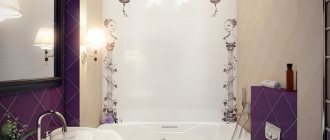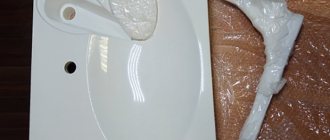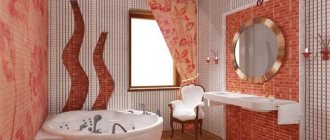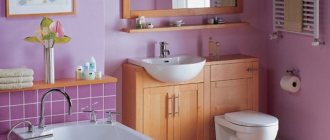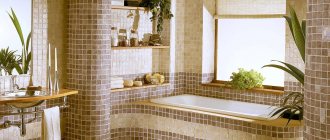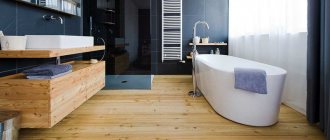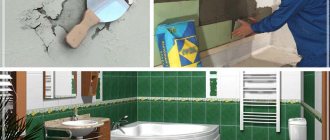As professionals in the field of interior decoration of apartments say, bathroom design is a compromise between aesthetics and practicality. It is very difficult to achieve a balance between these extremes, because the scales often tip to one side or the other. Nowadays there are so many current trends in bathroom interiors that it is difficult to single out just one.
While some continue to use such traditional materials as tiles, artificial stone and plastic, other designers propose using a fundamentally different option - brick. A brick wall in the bathroom is a bold accent, a reference to the loft style, which has remained popular for several seasons.
Features of the design solution
Now that people are already accustomed to tiled bathrooms, brickwork in the bathroom interior looks bold, bold and relevant in an innovative way. Although, of course, this technique is far from new.
The brick walls inside the bathroom refer us to the now extremely popular loft style, which imitates industrial premises converted for housing. The advantages of such a design solution are considered:
- Practicality. Brick is a very practical material that is unpretentious in maintenance and care and has sufficient resistance to moisture. Moreover, the porous structure of the brick will allow it to absorb excess moisture contained in the air of the bathroom, regulating the humidity level.
- High decorative potential . The design of a bathroom with a brick wall can be used in different stylistic directions: loft style, chateau style or rustic. This is a universal expressive tool that will help make a room more textured and distinctive in small ways.
- Availability . Unplastered brickwork or its imitation is much cheaper than it looks.
- Versatility . Brick can be finished in almost any way - painted, faced, plastered, if you get tired of the wall.
Advantages of ceramic material
- lightness in weight;
- increased strength and durability;
- low water absorption rates;
- excellent frost resistance and resistance to fading under the influence of sunlight and aggressive environments;
- safety for humans.
Ceramics are used in the kitchen, in hallways, and in places where brick imitation is required, since using real brick would be irrational. For example, for decorating loggias, balconies, fireplaces or arches.
Manufacturing methods
Even if you want to make a brick wall in the bathroom of a new building, it is quite possible to do this if you approach this issue with imagination and imagination. Designers note that it is absolutely not necessary to lay a partition out of real brick, because you can artificially imitate masonry.
There are the following options for implementing this idea:
- If you know for sure that the bathroom walls are made of brick, then you just need to remove their lining and then knock off the plaster. Such a wall will look authentic and harmonious. This option is suitable if the house has historical value.
Brickwork in the bathroom - Another option is to make a new wall out of brick. Moreover, you can artificially age the masonry so that it looks as if it has been there for a hundred years. It is important when laying not to adhere to too strict geometry. Achieve the effect of antiquity if you use old bricks left over from dismantling old houses.
- You can also imitate brickwork using special panels. This will cost almost the same as making a new wall, but the labor required to make it is much less.
Panels imitating brickwork - You can imitate masonry using moisture-resistant plaster, molar tape and a ruler. This is the cheapest, but most labor-intensive method.
Remember that for masonry you need to use not ordinary sand-lime brick, but red fired ceramic brick. It costs more, but it is more resistant to high humidity.
Brick-like ceramic tiles - visual effects
Decorative brick has a very wide variety of colors and textures. Shades can range from white and cream to black. Such tiles can be the color of freshly baked clay or ancient brick darkened over time. Decorative brick-like tiles come with or without a pattern, glazed or matte, smooth or rough. It does not necessarily have the size and shape of a standard rectangular briquette. Such tiles can be narrow or wide, rounded, curly or have a shape resembling a trapezoid.
Cladding with decorative brick-like tiles contrasts effectively with smooth surfaces lined with plain glazed tiles in a contrasting color. This material opens up many possibilities for design experiments. For example, you can create the effect of old brick that appears through the plaster. To do this, the walls are covered with plaster, into which inexpensive brick-like tiles are “recessed” in fragments. After this, the tiles are rubbed with putty until they merge with the surface of the wall. Finally, the wall is covered with light paint.
Bathroom brickwork
A bathroom with a brick wall is a current solution for the interior, which immediately makes it noble and aristocratic. Many homeowners are afraid that the masonry will look rough, however, this will not happen if you follow these tips:
- Masonry is an active accent spot in the interior, so it is enough to highlight one wall in this way.
- Red brick without plaster makes the room visually darker, so intense lighting will be required inside the bathroom.
- If the brickwork is of dark shades, then you need to use as many light shades as possible for the interior to balance the color balance.
Please note! Brick is a strong, durable material, but it can collapse when exposed to moisture, so it must be protected from moisture, mold and mildew.
Options for decorating different rooms with decorative bricks
There are a great many options for finishing an apartment with brick imitation. This design is often used in corridors and hallways.
But using it in the bedroom and living room will also look stylish. They frame fireplaces, TVs, and create niches. Door and window openings finished with similar materials look good. In hallways, mirrors are hung on the brickwork.
You can cover all the walls, but this option is more suitable for non-residential premises and for entertainment venues. It is better to cover only part of the wall with bricks, or one wall completely, because this coating looks great in combination with other facing surfaces.
Door and window openings finished with similar materials look good.
This design will look original in the bathroom; you can combine it with mosaics.
This type of installation is most often used in loft, hi-tech, and country styles. It is important to draw up a project in advance in order to calculate where it is best to apply such decor.
This design will look original in the bathroom.
Useful video
As professionals in the field of interior decoration of apartments say, bathroom design is a compromise between aesthetics and practicality. It is very difficult to achieve a balance between these extremes, because the scales often tip to one side or the other. Nowadays there are so many current trends in bathroom interiors that it is difficult to single out just one.
While some continue to use such traditional materials as tiles, artificial stone and plastic, other designers propose using a fundamentally different option - brick. A brick wall in the bathroom is a bold accent, a reference to the loft style, which has remained popular for several seasons.
Installation
You will have to divide the work into four stages:
- Prepare the surface. Make the surface of the walls as even as possible so that later your tiles do not go into waves. To do this, eliminate the protrusions on the wall, but do not touch the depressions, as they will be filled with special glue and make the fixation more reliable. After leveling work, treat the surface with a primer and let it dry well.
- Prepare the adhesive according to the instructions for use and apply it to the tiles. Moreover, you can apply the mixture directly to the base of about three tiles or cover the product itself with glue. At the same time, make sure that the thickness of the mixture layer does not exceed one centimeter. Then you make notches with a special spatula so that the mixture sinks better under the tile.
- Now you can proceed to facing work. Start laying tiles from the corner, but before doing so, calculate the required number of rows to switches and sockets so that you have to cut as few tiles as possible when fitting. After this, press the tiles against the prepared wall surface, and if there is glue sticking out somewhere, remove the excess with a rubber spatula. At the same time, try to carefully join the tiles to create an imitation of brick tiles.
- And lastly, rub the seams. After completing the tile laying work, and after waiting some time for the glue to at least partially dry, treat the seams with a special grout using a rubber spatula. Once everything is completely dry, wipe the tiles with a damp cloth or soft sponge soaked in water.
Brick-like tiles are a pretty stylish solution for bathroom design
Options for simulating decorative bricks in the interior: finishing materials
Brickwork in the interior of an apartment makes the room interesting and cool in the summer, and if the masonry is decorated with wooden crafts, then in winter it will be a warming element of the interior. Wood brings warmth.
Imitation of decorative bricks can be made from different materials from paint to stone.
The entrance to the apartment is laid out in the corridor with gypsum tiles. Varnishing provides protection from abrasion and impact, while at the same time making the interior unusual.
At the bottom of the walls, brickwork is made to protect the coating from pets. Everyone knows how cats love to scratch wallpaper. With the slabs the walls will remain intact.
The bathroom is special - sudden changes in temperature, high humidity. Therefore, if you want to highlight shelves with accessories, then a clinker model is suitable. It is not afraid of moisture, like gypsum or wallpaper, at the same time, the manufacturers of this tile have made a wide selection of colors and for various designs, loft and Scandinavian styles.
How to decorate walls around imitation brick: options
The surface design around the decor is carried out according to the overall interior. This could be painting the wall. The color is chosen lighter than the brick, but at the same time it should be in harmony with the general background.
Wallpaper is also chosen to be light. Wallpaper with a pattern is not acceptable. Basically it is a monochromatic material.
Photo wallpapers are selected carefully so that the brick complements the overall picture and does not stand out. 3D wallpapers are also selected.
Sometimes there is a combination of cladding and wood. But this should be approached with caution - natural wood should be present in the decor of the room.

